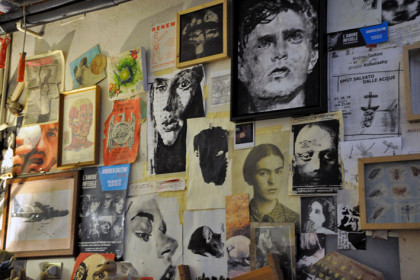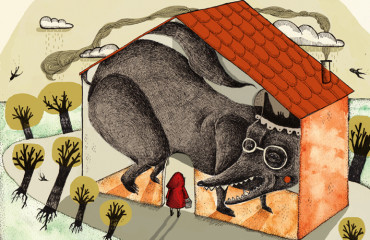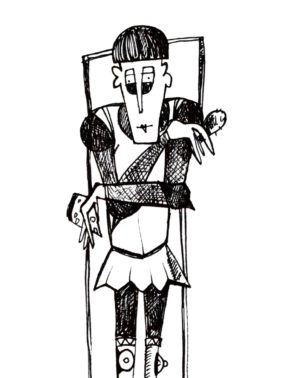
“I paint almost in the dark, I leave on only one light bulb, you see? Just so you can make the light and shade… sometimes even turn off the light and work by candlelight.”
Those distinctive chiaroscuro are the “fingerprint” of Andrea Saltini’s works, they are the brush strokes that give expression to portraits, the dark atmosphere punctuated with wild animals and monsters. No colors, only white chalk with which he prepares the canvas according to an ancient technique, and the black bole: pasty pigments, because for the artist sign is not so important, but texture and gesture. This results in a soft edges monochromatic output, slightly fuzzy, which makes us think of “unfinished”, expression of action on which the artist never returns with more interventions and from which he manages to come off quickly.
Facing these enigmatic faces, these so balanced compositions, I ask him what is the role of design in its operational mode. “None,” he answered. Design was exercise, it was childhood, it has been a training. Now Andrea Saltini works directly on the canvas with his cut brush, with blacks and whites, and on support materializes literally an image already formed in the artist’s head, and he does it with vehemence, with uncontrollable power and with impulsivity, almost like trying to get rid of a vision.
Saltini spent an apprenticeship at a ceramist in Faenza, he studied scenic design – because he was attracted by large surfaces to be painted – and he finally arrived to the size of the painting, which now belongs to him completely, and that is just completely owned. As for the subject, they are the preferred choices since he was a child: the ideas are often born from the memory of Aunt Delia’s tales, from strange stories, fascinating and terrifying from Bassa between Po and Mincio, and mingle with literature (Ophelia, between all of them), with Grand Guignol’s theater of horror, but also recall fairy-tale characters, as in the case of the amazing series of Hansel and Gretel. Recurring themes of water, sexually ambiguous figures, adolescents with female mouth on a man’s face, bodies abandoned and absent, a boundary between wakefulness and sleep.
Independent and adored by his “assatanate collectors” who vigorously contend new works and often fulfill the role of authentic patrons financing new projects, Saltini has great prospects revealing: After his participation in the 55th Venice Biennale of 2013 (Hall of Costa Rica in San Stae) an artist residence at Pavia is waiting for him, where he will work on the theme of memory – yet his childhood – and then begin a new journey to the other side of the world, to Beijing.
 English
English  Italiano
Italiano 



